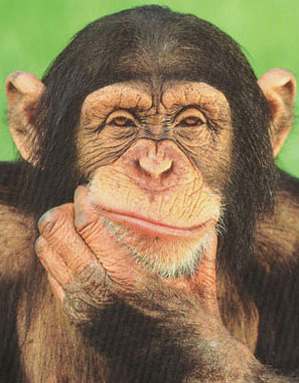
Description: hmmmmmmm?
Image copyright: http://images.google.com/imgres?imgurl=http://www.solarnavigator.net/animal_kingdom/animal_images/Chimpanzee_thinking_poster.jpg&imgrefurl=http://www.solarnavigator.net/animal_kingdom/mammals/chimpanz
The chimpanzee lives in and around the tropical rainforest of 21 equatorial African countries including Uganda, Rwanda, Burundi, and Tanzania. They may also be found in the forests, grasslands and savannas where its food is accessible year round. The chimp is omnivorous. Its diet includes ripe fruit, plants, leaves, buds, blossoms, seeds, soft pith, tree bark, insects and small mammals. It obtains its food by foraging and hunting. They live in groups of up to 120 where they use facial expressions, gestures, sounds, and posturing to communicate. They move around by "knuckle-walking," climbing, or by swinging from the branches of the trees.
The chimpanzee, like other organisms, is made up of organ systems. Three of these systems include the circulatory, digestive, and musculoskeletal systems.
In the circulatory system, the heart pumps blood through tubes called arteries to all parts of the body. The blood carries oxygen and nutrients, obtained by the digestive system and the respiratory system, which the body needs. Veins carry blood back to the heart as well as carry waste away from cells.
The digestive system breaks down food into proteins, vitamins, minerals, carbohydrates and fats, which the chimp needs for energy and growth. After the food is chewed and swallowed, it goes into the tube-like esophagus and then proceeds to the large stomach. The acids, bacteria and protozoa in the stomach break down the food. From there, the food goes into the small intestines where it is broken down into nutrients. The bloodstream absorbs the nutrients and carries them to other systems in the chimp body. Any food not needed or not digested is turned into waste and eliminated from the large intestine and bowel.
The musculoskeletal system is made up of fibrous tissues and bones which work together to hold the body upright and to control its movement. It also protects other organs such as ribs protecting heart and lungs. Some of the larger muscles or skeletal muscles that provide mobility and movement are voluntary muscles. Other muscles, such as the heart, blood vessels, and intestines are involuntary muscles and are controlled by the nervous system. The chimps forward leaning structure differs from erect man due to its longer forward tilting pelvic bone, larger shoulder blades, longer arms, and shorter legs.
This page was
edited
by pinen88 (Teacher: Preston) using
Web Poster Wizard.